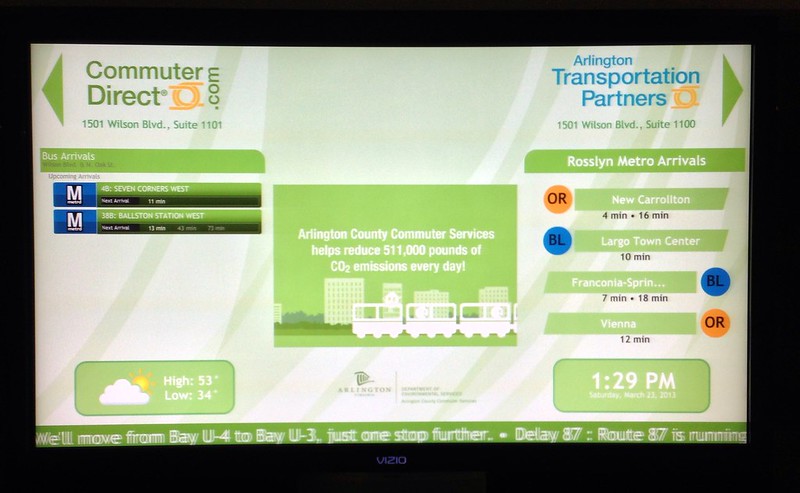There are so many things in just the title of this post that is new learning for me. Let’s count them:
- There is automated community walking data available, because Arlington, Virginia has installed electronic meters on its walking trails (see: National Bicycle and Pedestrian Documentation Project :: Home)
- This data is available for download and via web service (see: Bicycle & Pedestrian Counters)
- There is a mobility lab in this region, (@mobilitylabteam) a unique organization in our nation, part of Arlington Department of Environmental Services, that is
- The home of cutting-edge original transportation research,
- A convener and engager of top minds on the topic locally in the DC region, nationally, and worldwide, and
- The leading online source for how we can improve society by offering a better and healthier array of transportation options.
I learned about this at mobility hack day, which was held at the Lab this past weekend. By the way, “mobility” refers to transportation, rather than “mobile technology,” although the two are commingled in this world…
This information is a bit of a revelation for me because I have been following all of the amazing analysis and visualizations of Capital Bikeshare (@bikeshare), the nation’s largest (and most awesome) bike sharing service, which has made its data available for download. This is just one example from community colleague MV Jantzen. I didn’t realize that walking could be measured (since I assumed, unlike a bike, you don’t check out your feet at a walk station).
Well it turns out that you can, via specially designed meters that have different characteristics suitable for measuring walking indoors our outdoors. It seems like there’s as much science behind these as there is for many medical tests we order (sensitivity/specificity, etc). Again, I was not aware, until now.
Why Arlington?
Why, do you ask, does Arlington, Virgina have a nation-leading organization like mobility lab? Here’s a clue (from Wikipedia):
With a land area of 26 square miles (67 km2), Arlington is the geographically smallest self-governing county in the United States and has no other incorporated towns within its borders. Given these unique characteristics, for statistical purposes the county is included as a municipality within the Washington Metropolitan Area by the United States Census Bureau. As of 2012, Arlington County had a population of 220,565 residents. It would be the fourth-largest city in the state if it were incorporated as such.
Think about the management of growth that this must require, and necessity is the mother of innovation….
Walking and Mondays, my quick little data hack
My little hack was pretty simple. I just downloaded pedestrian counts from three points in Arlington’s trail system and wanted to visually review what Mondays looked like relative to the rest of the week. This analysis is important, because there’s behavioral science to show that Mondays have special significance in changing behavior and it may be more effective to start a change on Monday, and continue that change on a Monday, for lasting effect. The Monday Campaigns have highlighted this and leveraged it to success in multiple venues/campaigns. Check it out. and review “The Science behind the Monday Campaigns“
My hack above has significant methodologic problems, most notably that it doesn’t take the weather into account.
Let’s assume for a second, though, that it’s correct. If it is, it may show a picture of people walking on trails mostly on weekends with a drop-off during the work week. Imagine that you are an employer then in the area, and could start a Monday campaign, by encouraging your employees to conduct walking meetings on Mondays or walking to work on Mondays.
First, you could use this data to see impact – since it counts down to the pedestrian.
Second, you could report this data back and use it to see a smoothing of walking throughout the week. In other words, Monday could be the “The Day All Health Breaks Loose” and over time, there would be more weekday walking.
And I’m still impressed that walking can actually be counted without expensive pedometers or app installations. Have I mentioned that a few times already? 🙂
I guess point #3 is that more employers could install pedestrian counters to support walking initiatives across all their locations.
I’d like a few of these
And now, just as I joke that I’d like to have a functional MRI to discover the secrets that other industries use to promote unhealthy behavior, I’d like to have one, or 600 of these sensors to track walking where people live, work, learn, and play.
Thanks again, Mobility Lab, for opening your doors to all. Special thanks to Sridevi Beidha from Redmon Group, who with a single utterance of a URL, made rainbows come into the room. Transportation and Health are really collaborating now.
Coming in April: Center for Total Health Community Tour, focus on Transportation and Health
As the heading says, we’re keeping the collaboration going. See you in April. Watch this space for details on time and place.


3 Comments
A Hack Day star is born! Hacking Community Walking Data with the Arlington, Virginia, Mobility Lab http://t.co/2vsQ5fBbuc via @tedeytan
RT @MobilityLabTeam: A Hack Day star is born! Hacking Community Walking Data with the Arlington, Virginia, Mobility Lab http://t.co/2vsQ5fBbuc via @tedeytan
MT @MobilityLabTeam: A Hack Day star is born! Hacking Community #Walking Data w/ the Arlington VA Mobility Lab http://t.co/EEgrOqYkyz